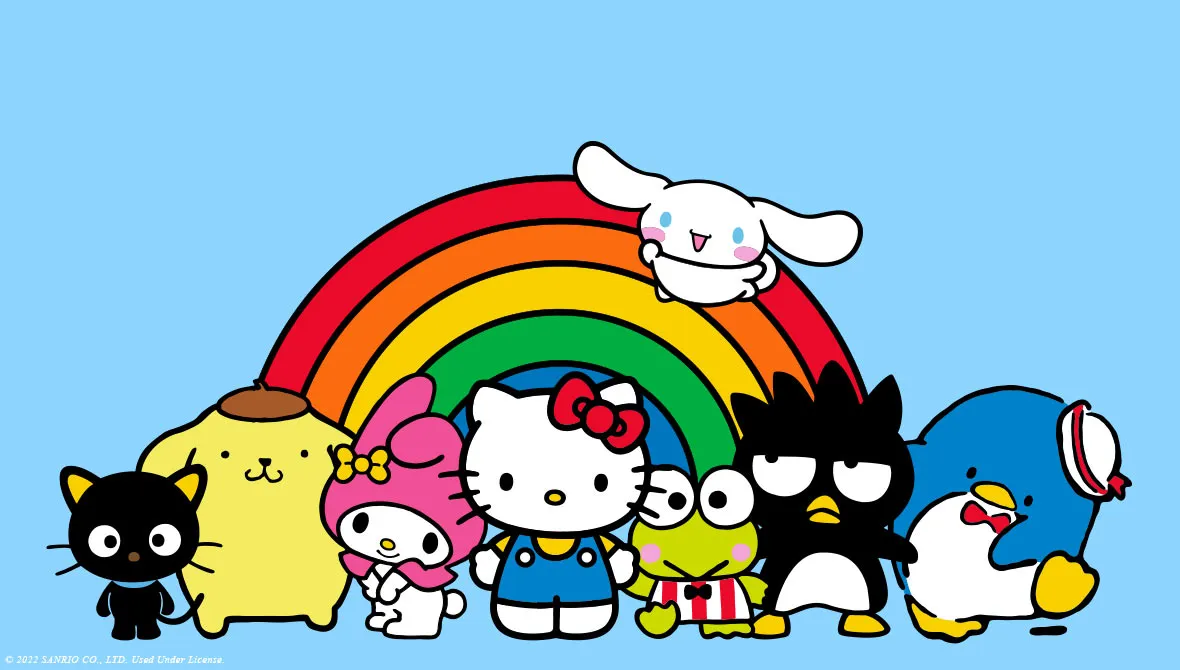Sanrio is a globally recognized brand known for its charming and iconic characters like Hello Kitty, My Melody, and many others, all of which epitomize the kawaii (cute) culture of Japan. For over 60 years, Sanrio has captivated millions with its distinctive style and vast array of products, making it a beloved name across generations.
Sanrio is much more than just Hello Kitty; it’s a universe of characters and products that embody a unique blend of whimsy, nostalgia, and charm. Whether you’re a longtime fan or just curious about this cultural phenomenon, this guide will take you through everything you need to know about Sanrio—from its history and popular characters to its diverse range of products and global influence.
Table of Contents
The Origins of Sanrio: A Journey into Kawaii Culture
Sanrio’s story begins in 1960 when Shintaro Tsuji founded the company in Japan under the name Yamanashi Silk Company. The company initially started by selling silk products but soon transitioned into producing small, cute gifts. Shintaro Tsuji realized that adding a touch of cuteness to everyday items could make them more appealing. This insight marked the beginning of what we now recognize as kawaii culture, a defining aspect of modern Japanese pop culture.
The word “Sanrio” itself is a blend of two words: “San,” which means “three” in Japanese, and “Rio,” which means “river” in Spanish. The name symbolizes the connection between different cultures, a theme that runs throughout the company’s history as it expanded from a small Japanese company to a global phenomenon.
The birth of Hello Kitty in 1974 was a pivotal moment for Sanrio. Designed by Yuko Shimizu, Hello Kitty quickly became the face of the company and a cultural icon in her own right. Her simple, endearing design, with no mouth and a red bow on her head, has resonated with people worldwide, transcending language and cultural barriers.
Sanrio’s Most Popular Characters: Beyond Hello Kitty
While Hello Kitty remains Sanrio’s most famous character, the company has created a wide range of characters, each with its own personality, backstory, and fan base. Here are some of the most beloved Sanrio characters:
My Melody: Created in 1975, My Melody is a sweet rabbit character known for her red or pink hood that covers her ears. She loves baking cookies with her grandmother and is often seen with her best friend, a mouse named Flat.
Cinnamoroll: Introduced in 2002, Cinnamoroll is a white puppy with long ears that allow him to fly. He has a tail that looks like a cinnamon roll, which is how he got his name. Cinnamoroll’s adventures often take place in the sky, where he loves to fly and explore.
Kuromi: Kuromi, created in 2005, is My Melody’s rival and is often depicted as a mischievous, punk-styled character. Despite her tough appearance, she has a soft side, making her a complex and relatable character.
Keroppi: This green frog character was introduced in 1988. Keroppi lives with his family on Donut Pond and enjoys playing games, especially with his friends. His cheerful and energetic personality has made him a favorite among fans.
Badtz-Maru: Badtz-Maru is a mischievous penguin with a spiky head and a perpetually grumpy expression. Created in 1993, he is a bit of a troublemaker, always finding himself in amusing predicaments.
These characters, along with many others, form the heart of Sanrio’s brand. Each character has its own set of products, ranging from plush toys and stationery to clothing and accessories, allowing fans to connect with their favorite characters in various ways.
Sanrio Products: A Wide Range of Kawaii Merchandise
Sanrio is known for its extensive product line, which includes everything from household items to high-end fashion collaborations. The company has mastered the art of character merchandising, turning its characters into brands in their own right.
Plush Toys: One of the most popular Sanrio products is plush toys. Fans of all ages collect plush versions of their favorite characters, which come in various sizes and designs. These plushies often become cherished keepsakes or gifts.
Stationery: Sanrio’s stationery items are equally popular. From notebooks and pens to stickers and calendars, these items often feature intricate designs and are loved by both students and professionals. Sanrio stationery is not only functional but also adds a touch of kawaii to everyday tasks.
Fashion and Accessories: Over the years, Sanrio has collaborated with numerous fashion brands, creating unique clothing lines and accessories. These collaborations often result in limited-edition items that are highly sought after by collectors. From Hello Kitty handbags to My Melody jewelry, Sanrio products have made their way into the fashion world, allowing fans to wear their favorite characters.
Home Décor: Sanrio characters also adorn a wide range of home décor items, including bedding, kitchenware, and even furniture. These products bring the kawaii aesthetic into homes, making it possible for fans to create spaces that reflect their love for Sanrio.
Technology Accessories: In recent years, Sanrio has expanded into tech accessories, offering items like phone cases, headphones, and even laptops featuring their beloved characters. These products cater to the tech-savvy fan who wants to combine functionality with cuteness.
Sanrio Stores and Theme Parks: Experiencing the Magic in Person
Sanrio’s influence extends beyond products to immersive experiences that allow fans to step into the world of their favorite characters. Sanrio operates a variety of retail stores and theme parks that offer unique opportunities to explore the brand in person.
Sanrio Stores: Sanrio operates numerous stores worldwide, particularly in Asia, where fans can find a wide range of products under one roof. These stores are often designed to reflect the whimsical world of Sanrio, with vibrant displays and themed sections for each character. The flagship Sanrio store in Tokyo’s Ginza district is a must-visit for any fan, offering exclusive products and an immersive shopping experience.
Sanrio Puroland: Located in Tama, Tokyo, Sanrio Puroland is an indoor theme park dedicated to Sanrio characters. Visitors can meet Hello Kitty, My Melody, and other characters, enjoy live performances, and explore themed attractions. The park is particularly popular among families and young children, offering a day full of fun and kawaii experiences.
Harmonyland: Another Sanrio theme park, Harmonyland, is located in Oita Prefecture, Japan. Unlike Puroland, Harmonyland is an outdoor park featuring rides, shows, and parades themed around Sanrio characters. It’s an ideal destination for those who want to enjoy the charm of Sanrio in an open-air environment.
International Stores: Sanrio’s global reach includes stores in North America, Europe, and Asia. These stores cater to international fans, offering a curated selection of products and sometimes exclusive items not available elsewhere.
Sanrio Collaborations and Pop Culture Impact
Sanrio has a long history of collaborations with other brands and celebrities, further cementing its place in global pop culture. These collaborations often result in unique products that blend Sanrio’s kawaii aesthetic with the collaborator’s style.
Fashion Collaborations: Sanrio characters have appeared in collaborations with major fashion brands like Uniqlo, Coach, and Levi’s. These collaborations often include limited-edition clothing lines that feature unique designs, combining high fashion with the cute appeal of Sanrio.
Celebrity Collaborations: Sanrio has also partnered with celebrities to create special edition products. For example, pop icon Katy Perry has expressed her love for Hello Kitty, leading to a collaboration that produced exclusive merchandise.
Entertainment Collaborations: Sanrio characters have made appearances in various forms of media, including movies, TV shows, and video games. Hello Kitty, in particular, has starred in her animated series and even made guest appearances in other popular shows. These media appearances help introduce Sanrio characters to new audiences and keep them relevant in a rapidly changing entertainment landscape.
Sanrio in the Digital Age: Online Presence and Mobile Games
Sanrio has successfully transitioned into the digital age, offering a variety of online experiences and mobile games that cater to its tech-savvy fanbase.
Official Websites and E-Commerce: Sanrio operates several official websites that provide fans with information about characters, products, and upcoming events. The e-commerce sections of these sites allow fans to purchase products directly, making it easier than ever to access Sanrio merchandise.
Social Media Presence: Sanrio maintains an active presence on social media platforms like Instagram, Twitter, and Facebook. Through these channels, the company engages with fans, shares updates, and showcases new products. The social media presence also allows Sanrio to stay connected with a global audience, ensuring that fans worldwide can participate in the brand’s community.
Mobile Games: Sanrio has developed several mobile games that feature its popular characters. These games often combine puzzle-solving elements with character interaction, offering a fun and engaging way for fans to connect with their favorite characters. Some popular Sanrio mobile games include “Hello Kitty World” and “My Melody Land.”
Sanrio’s Influence on Global Pop Culture
Sanrio’s impact on global pop culture cannot be overstated. What began as a small Japanese company selling silk products has grown into a global brand that influences fashion, entertainment, and lifestyle trends worldwide.
The Rise of Kawaii Culture: Sanrio has played a significant role in popularizing kawaii culture beyond Japan. The concept of kawaii, which emphasizes cuteness and charm, has become a global trend, influencing everything from fashion to social media aesthetics. Sanrio characters like Hello Kitty are often seen as ambassadors of this culture, representing the playful and endearing aspects of kawaii.
Cross-Generational Appeal: Sanrio’s ability to appeal to multiple generations is one of the keys to its enduring success. Adults who grew up with Hello Kitty and other Sanrio characters often pass their love for the brand to their children, creating a sense of nostalgia and continuity. This cross-generational appeal ensures that Sanrio remains relevant even as trends change.
Cultural Diplomacy: Sanrio has also been involved in cultural diplomacy efforts. For example, Hello Kitty has been appointed as a cultural ambassador for various initiatives, promoting friendly relations between Japan and other countries. This role highlights the positive and unifying influence of Sanrio characters on a global scale.
The Future of Sanrio: What Lies Ahead for the Kawaii Empire?
As Sanrio continues to evolve, the company shows no signs of slowing down. With a strong foundation in both physical products and digital experiences, Sanrio is well-positioned to continue its influence on global pop culture for years to come.
Expanding Digital Offerings: The future likely holds more digital ventures for Sanrio. With the rise of virtual reality and augmented reality, Sanrio characters could soon inhabit these spaces, offering new ways for fans to interact with them. Additionally, the continued development of mobile games and online platforms will likely be a focus, as these areas offer significant growth potential.
Sustainability Efforts: As global awareness of environmental issues grows, Sanrio is also likely to increase its focus on sustainability. This could involve developing eco-friendly products and packaging, as well as supporting environmental causes. Aligning with these values will help Sanrio resonate with a new generation of consumers who prioritize sustainability.
New Character Development: While Hello Kitty remains the face of Sanrio, the company is known for periodically introducing new characters to keep the brand fresh and exciting. Future characters will likely reflect contemporary trends and values, ensuring that Sanrio remains relevant in an ever-changing market.
Global Expansion: Sanrio’s global presence is set to expand further, with new stores, theme parks, and collaborations in the works. As the brand continues to grow, it will likely explore new markets and opportunities, bringing the joy of Sanrio to even more people worldwide.
FAQs
What is Sanrio best known for?
Sanrio is best known for creating Hello Kitty, one of the most iconic characters in the world, as well as other beloved characters like My Melody, Cinnamoroll, and Kuromi. The brand is synonymous with kawaii culture and has a wide range of products, from plush toys to fashion accessories.
How did Sanrio start?
Sanrio started in 1960 as the Yamanashi Silk Company, initially selling silk products. The company shifted focus after founder Shintaro Tsuji realized the appeal of adding cute designs to everyday items, leading to the creation of Sanrio and its first characters.
Where can I buy Sanrio products?
Sanrio products can be purchased at official Sanrio stores, online through Sanrio’s e-commerce websites, and in various retail stores worldwide. Exclusive items are often available in Sanrio’s flagship stores in Japan.
What is Sanrio Puroland?
Sanrio Puroland is an indoor theme park in Tokyo dedicated to Sanrio characters. Visitors can meet characters like Hello Kitty and My Melody, enjoy themed attractions, and watch live performances, making it a popular destination for families.
Why is Hello Kitty so popular?
Hello Kitty’s popularity can be attributed to her simple and versatile design, which resonates with people of all ages. Her lack of a mouth allows fans to project their own emotions onto her, making her universally relatable. Hello Kitty has also been the face of countless products and collaborations, keeping her in the public eye for decades.
What does Sanrio mean?
The name “Sanrio” combines “San,” which means “three” in Japanese, and “Rio,” which means “river” in Spanish. The name reflects the company’s mission to connect different cultures through the universal appeal of cuteness.
Conclusion
Sanrio’s legacy as a pioneer of kawaii culture and a global brand is undeniable. From its humble beginnings in Japan to its current status as a cultural phenomenon, Sanrio has captured the hearts of millions with its charming characters and diverse range of products. Whether through plush toys, fashion, or digital experiences, Sanrio continues to bring joy and creativity to fans around the world, proving that the appeal of kawaii is truly universal.
For more interesting articles, keep visiting our blog myskyic












